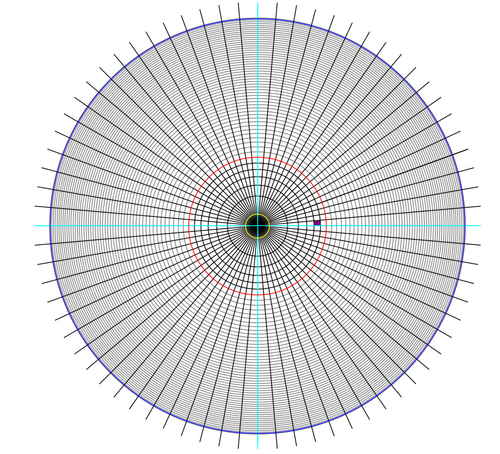3SGS (A1-0): Difference between revisions
(Created page with "'''3SGS''', short for '''Standard Sector System of Galactic Subdivision''', is an authalic subdivision system that divides the Lampshade Galaxy into almost 4,000 sectors that all have an equal surface area on the galactic plane (almost 15,882,500 ly²). They have the same height, 1,000 ly, so their volumes are also equal. center|thumb|500px|Top view of all 3SGS sectors. [[Sector A1-0 (A1-0)|Sector A1-0 in purple.]] The 3SGS system divides t...") Tag: 2017 source edit |
No edit summary Tag: 2017 source edit |
||
| (2 intermediate revisions by the same user not shown) | |||
| Line 5: | Line 5: | ||
The 3SGS system divides the galaxy into rings that are further subdivided into 5°-wide segments (except for C series rings). The sectors are numbered counter-clockwise from the righthand horizontal cyan line and there is a total of 72 sectors in a ring. The rings are grouped into three series. The A series rings lie between the 50% border (red) that divides the galaxy into two portions that have roughly the same amount of stars in them and the border to the galactic bulge (yellow). The B series rings lie between the 50% border and the 99% border (blue) that encompasses roughly 99% of the galaxy's stars. The C series lie inside the galactic bulge border and has three layers as opposed to the one layer of the A and B series. | The 3SGS system divides the galaxy into rings that are further subdivided into 5°-wide segments (except for C series rings). The sectors are numbered counter-clockwise from the righthand horizontal cyan line and there is a total of 72 sectors in a ring. The rings are grouped into three series. The A series rings lie between the 50% border (red) that divides the galaxy into two portions that have roughly the same amount of stars in them and the border to the galactic bulge (yellow). The B series rings lie between the 50% border and the 99% border (blue) that encompasses roughly 99% of the galaxy's stars. The C series lie inside the galactic bulge border and has three layers as opposed to the one layer of the A and B series. | ||
Individual sectors are identified by which ring series they are in, then which ring (counting inward toward the galactic centre starting from 0) and lastly which of the 72 segments (counting counter-clockwise starting from 0). The ring and segment designators are separated by a dash (-). The galaxy is also divided into quadrants, but they are not included in the system designation. Thus, Sector A1-0 | Individual sectors are identified by which ring series they are in, then which ring (counting inward toward the galactic centre starting from 0) and lastly which of the 72 segments (counting counter-clockwise starting from 0). The ring and segment designators are separated by a dash (-). The galaxy is also divided into quadrants, but they are not included in the system designation. Thus, is e.g. Sector A1-0 in the A series, ring 1 and the 0th segment (coinciding with the border Alpha/Gamma quadrant border). | ||
[[Category:Collaboration stubs (A1-0)]] | |||
Latest revision as of 23:16, 9 July 2024
3SGS, short for Standard Sector System of Galactic Subdivision, is an authalic subdivision system that divides the Lampshade Galaxy into almost 4,000 sectors that all have an equal surface area on the galactic plane (almost 15,882,500 ly²). They have the same height, 1,000 ly, so their volumes are also equal.

The 3SGS system divides the galaxy into rings that are further subdivided into 5°-wide segments (except for C series rings). The sectors are numbered counter-clockwise from the righthand horizontal cyan line and there is a total of 72 sectors in a ring. The rings are grouped into three series. The A series rings lie between the 50% border (red) that divides the galaxy into two portions that have roughly the same amount of stars in them and the border to the galactic bulge (yellow). The B series rings lie between the 50% border and the 99% border (blue) that encompasses roughly 99% of the galaxy's stars. The C series lie inside the galactic bulge border and has three layers as opposed to the one layer of the A and B series.
Individual sectors are identified by which ring series they are in, then which ring (counting inward toward the galactic centre starting from 0) and lastly which of the 72 segments (counting counter-clockwise starting from 0). The ring and segment designators are separated by a dash (-). The galaxy is also divided into quadrants, but they are not included in the system designation. Thus, is e.g. Sector A1-0 in the A series, ring 1 and the 0th segment (coinciding with the border Alpha/Gamma quadrant border).